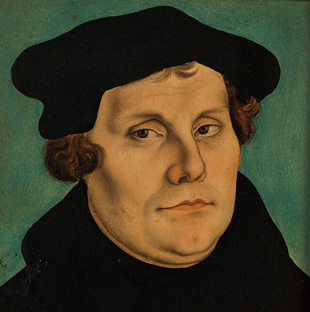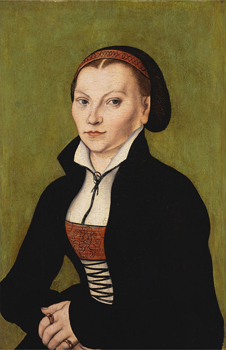For Sunday November 5, 2017
Lectionary Readings (Revised Common Lectionary, Year A)
Joshua 3:7–17 or Micah 3:5–12
Psalm 107:1–7, 33–37 or Psalm 43
1 Thessalonians 2:9–13
Matthew 23:1–12
For the month of October, Journey with Jesus is "Remembering the Reformation: 500 Years" with guest essays from five traditions: Catholic, Reformed, Anglican, Lutheran, and Orthodox. This week's essay is by Martha E. Stortz, Bernhard M. Christensen Professor of Religion and Vocation at Augsburg University. You may contact her at stortz@augsburg.edu.
Incarnation forces Christians to think about bodies. After all, God had a body. In Christ, God explodes into human history in human form. Authors of the canonical gospels themselves seem uncomfortable with the aftershocks. Two of them, Mark and John, introduce Jesus as an adult, walking, talking, and speaking with authority like a seasoned rabbi. Only Luke and Matthew include birth narratives, which extend incarnation into infancy and its messy vulnerability.
Christ is God’s body in the world, and the fact of incarnation persists, despite centuries of theological dispute about when and how God got that body, what in it is truly human or truly divine, whether that body felt pain or hunger or thirst or death. Incarnation has confounded theologians.
One theologian who reveled in the body was Martin Luther (1483–1546), and his embrace of corporeality struck “a new note” in theological thinking (Roper 2012, 150). Surely a revolution in doctrine, the Reformation also altered how people thought about and lived in their bodies. Looking at Luther’s “body language” underscores some of these shifts in thinking about the human body, God’s body, and the body politic.
The Human Body
Monastic training taught Luther to treat the body as an impediment to spiritual progress. As an Augustinian monk, he took seriously the asceticisms of poverty, chastity, and obedience, and they drove him to doubt that he could ever physically do enough to contribute to his own salvation. His Reformation discovery, that Christ had already accomplished what he could not, freed him to treat the body as one more site of conflict in an ongoing battle between God and the devil. While Christ had already won the war and would come again to declare final victory, until that time, skirmishes abound. Luther looked at the bodies around him as another battleground, not as the enemy.
 |
|
Wedding portrait of Martin Luther, by Lucas Cranach the Elder (1529).
|
Accordingly, Luther writes with appreciation for bodies. As a biblical scholar, he attended to the bodies that animated the texts. Writing on Genesis, Luther described the first inhabitant of the Garden of Eden as “intoxicated with rejoicing.” Adam frolics before the fall. Full-body delight, not some passive beatitude, is humankind’s natural state. Even after the incident with the forbidden fruit, bodies are not demonized, and Luther treats them with realism, even humor. He described to a friend his son’s successful toilet-training; young Hans learned to squat so well he “crapped in every corner of the room.” He argued against clerical celibacy on grounds of human necessity. Sex is natural to humans, and “the Pope has as little power to command this, as he has to forbid eating, drinking, the natural movement of the bowels, or growing fat.” Luther urges a woman whose husband refused to consummate their marriage to “flee to a foreign country” and contract a proper union.
Eventually, Luther contracted a proper union himself, marrying the runaway nun Katerina von Bora. A marriage of mutual respect grew into deep affection. When he cannot attend the wedding of a trusted counselor, Luther promises him that on his wedding night he would think of him and “I shall make love to my Catherine while you make love to yours, and thus we will be united in love.” Sex here is neither demonized nor sacralized, but is rather part of being human — and one of the more pleasurable parts at that.
In his pastoral counsel and commentaries, Luther exercises more vigilance over other organs: the ears and the mouth. In his Genesis commentaries the stories of creation and fall are oral and aural events. Three words animate worlds: “And God said….” When humans enter the creation, God speaks (deus loquens); the creature listens (homo audiens). Created in the image of this kind of God, the man is invited to speak in turn, and he names all the other creatures in obedience to God’s invitation. Importantly, obedience in the context of a divine-human dialogue literally means “listening for” God’s word (ob- + -audire). And first man and woman do — until they don’t. In Luther’s hands, the fall interrupts an ongoing conversation. The serpent tempts the couple by persuading them to doubt God’s word.
Luther’s interpretation of the fall as a conversation gone wrong lends force to his catechetical instruction on the Ten Commandments. Not surprisingly, Luther focuses on the ears and the mouth. Turning even the “thou shalt not” commandments into positive injunctions, “thou shalt,” he raises the bar for believers’ conversation with God and with others. Not only should they not profane God’s name, but “call upon him, pray to him, praise him, and give him thanks.” The Sabbath is a time for listening, where one “gladly hears and learns” God’s word. Writing on the commandment not to bear false witness, Luther urges believers to “speak well” of the neighbor, charitably interpreting all that he does. Words spoken, heard, and written have physical force.
The invention of the printing press in 1450 amplified the impact of words. Mass-produced print material was widely available, and growing literacy rates meant people could read it. Although trained as a university professor and capable of writing in Latin, the language of the academy, Luther preferred the language of the people. He mastered it, becoming one of the best-selling authors in vernacular German. His translation of the Bible carried the lively speech rhythms of a seasoned preacher. Listening to the everyday cadences of “the mother in the home, the children in the street, the common man in the market place,” he described his technique as “looking them in the mouth to see how to speak.” It’s striking tribute to the most important parts of the body. But then again, Luther intended his translation of the Bible to be proclaimed, not read silently on one’s own. After all, the disciples were commissioned not to write the good news but to go and preach it. “The Gospel should not be written, but shouted.” And shout Luther did. The incarnate word was a living word, a word proclaimed.
The Body of Christ
“And God said….” The word God spoke in creation was the word that became flesh. But God still speaks; the incarnation persists. Where can one hear God speak today? Where can one find the body of Christ in the world today? Luther tackled these questions toward the end of his life, when a split with the Roman Catholic church became inevitable. His directions for finding Christ’s body in the world roll out like an ancient hymn:
“Where you find people preaching and hearing the Word; baptizing;
…breaking bread;
…forgiving and being forgiven;
…calling out leaders;
…praying, praising, teaching their children;
…walking in the way of the cross;
There you find the church.”
Proclamation, baptism, the Lord’s Supper, penance, ordination, catechesis/prayer/praise, discipleship: where people engage in these practices, there is the church. Significantly, Luther does not locate the church in an institution, a papacy, a place of any sort, but in a people, specifically, a people engaged in certain practices that mark their bodies like the wounds of his torture and execution marked the body of the crucified and risen Christ.
Given his attention to the ears and the mouth, it makes sense that Luther regarded the preaching and hearing of the word as the central practice. Proclamation orients the other practices like the sun anchors the solar system. All the other practices revolve around it, constituting the body of Christ in the world.
The Body Politic
 |
|
Wedding portrait of Luther's wife Katharina von Bora, by Lucas Cranach the Elder (1526).
|
Beyond these practices, Luther gave additional direction to anyone who wants to find the body of Christ in the world today. These too pointed not to place but to people. His central political unit is the neighborhood, and he regarded citizens as neighbors. He counseled believers to “bear the face of Christ” to the neighbor, particularly the neighbor in need. This was no pastoral platitude, but a matter of practical urgency. Leaving the Roman Catholic church meant erasing social services that cathedrals, monasteries, and convents supplied. Reformation cities quickly needed to devise some way of caring for the poor in their midst. There were lots of neighbors in need.
But Luther also reminded believers that the neighbor bears the face of Christ to them. Christians are to “be” Christ to the neighbor, but also to “see” Christ in the neighbor. Neighborhoods functioned on the basis of mutual beholding, as citizens bore the face of Christ to the neighbor and found the face of Christ in the neighbor in return.
Concluding Thoughts on Luther's Legacy
Luther himself did not always “see” Christ in the face of his neighbor, certainly not the neighbor who was Jewish or Muslim. Luther shouted down the centuries, but his content was not always the gospel. Nor did Luther the polemicist follow the counsel of Luther the pastor. As a polemicist, he did not “speak well” of his opponents, and he shoveled invective on representatives of the popes and princes alike when his theological proposals led to excommunication and exile. Add to that Luther’s later tirades against the Jews, the “Turks,” and the “murdering hordes of peasants,” and one finds a clear path through Nazi Germany and into the current hate-filled populist movements of the present. The reformer left behind a rhetoric that demands repentance, not just in words but in embodied actions. Any piece on Martin Luther must make amends for the reformer’s hate speech, because hate speech continues the crucifixion, breaking the body of Christ still further.
In this year of the 500th anniversary commemorating the posting of Luther’s 95 Theses to the door of the Wittenberg cathedral, one way to repent is to refrain from hagiography and to re-member the reformer whole, celebrating his stunning accomplishments without downplaying his equally stunning failings. This is the only fitting tribute for a man who considered himself, in the words of one of his most famous aphorisms, simultaneously a saint and sinner, simul justus et peccator.
Resources
Luther, Martin. “The Freedom of a Christian,” in Harold Grimm & Helmut Lehmann (eds.), Luther’s Works, Vol. 31. Philadelphia: Fortress Press, 1957.
--- “Lectures on Genesis, Chapters 1–5,” in Jaroslav Pelikan (ed.), Luther’s Works, Vol. 1. St. Louis MO: Concordia Publishing House, 1958.
--- “The Small Catechism,” in Theodore Tappert (ed.), The Book of Concord. Philadelphia: Fortress Press, 1959.
Miles, Margaret. The Word Made Flesh: A History of Christian Thought. Malden, MA: Blackwell Publishing, 2005.
Oberman, Heiko. Luther: Man between God and the Devil. New Haven: Yale University Press, 1989.
Pettegree, Andrew. Brand Luther. New York: Penguin, 2015.
Roper, Lyndal. Martin Luther: Renegade and Prophet. New York: Random House, 2016.
Westhelle, Vitor. Transfiguring Luther: The Planetary Promise of Luther’s Theology. Eugene OR: Cascade Books, 2016.
Image credits: (1,2) Wikipedia.org.





